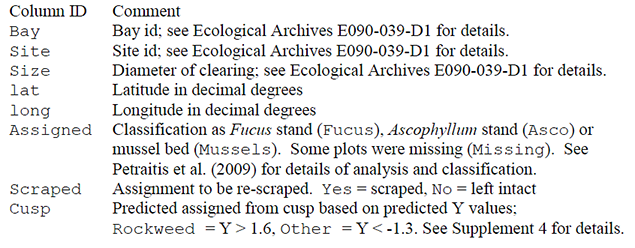Data file contains information about locations of plots and assignment of plots. The experimental plots were initially established in Ascophyllum nodosum stands at twelve mid intertidal sites with three sites in each of four sheltered bays on Swan’s Island, Maine in 1996 to test the hypothesis that mussel beds and fucoid stands were alternative community states. Two bays faced north, towards the mainland (Mackerel Cove and Seal Cove) and two faced south towards the open sea (Burnt Coat Harbor and Toothacker Cove). At each site, four circular clearings (1, 2, 4, and 8 m in diameter) were made, and an uncleared control plot was set up. Clearings were set-up and initially scraped during the summer of 1996 and then re-scraped in February 1997 to mimic the effects of winter ice scour. Scraping was done with paint scrapers and removed A. nodosum plants and holdfasts, barnacles, mussels, and other organisms. The effect of the scraping was similar in effect to a severe ice scour event, which completely removes everything from the surface. Sizes of experimental clearings were well within the range of natural clearings (natural clearings created during the winter of 2002–2003 by ice scour averaged 25.4 m² and ranged from 2.4 to 78.5 m², P. S. Petraitis, unpublished data).
We used three criteria to select which plots to re-scrape in 2010. First we attempted to re-scrape no more than half the plots in each bay to control for variation among bays. Likewise, we re-scraped half of the plots at each level of clearing size. Finally, Petraitis et al. (2009) classified plots having become mussel beds or rockweed stands, and so we attempted to re-scrape half the plots in each group. Plots were initially re-scraped in August 2010 and then scraped again in early March 2011 to mimic winter ice scour.

References
Petraitis, P. S., E. T. Methratta, E. C. Rhile, N. A. Vidargas, and S. R. Dudgeon. 2009. Experimental confirmation of multiple community states in a marine ecosystem. Oecologia 61:139–148.